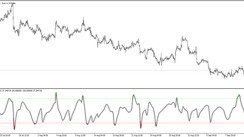Day trading is a demanding endeavor that necessitates a mix of expertise, extensive practice, and a deep understanding of the financial markets. It's worth noting that as a novice day trader, you'll be competing with seasoned professionals equipped with top-tier technology and industry connections. Their success could potentially come at your expense.
Moreover, it's crucial to bear in mind that your profits, however modest, will be subject to taxation. Short-term gains — from investments held for less than a year — are taxed at the marginal rate. On the bright side, your losses can counterbalance your gains.
As a rookie day trader, emotional and psychological biases may impact your decision-making, especially when your personal funds are at stake. Overcoming these obstacles is often easier for experienced traders who have significant financial resources at their disposal.
According to a study conducted by the Securities and Exchange Commission, many traders exhaust their entire capital within a year.
Choosing What to Buy and When to Buy
Identifying the Right Assets
Day traders aim to capitalize on minor price fluctuations in various assets, such as stocks, currencies, futures, and options, often employing substantial capital to do so. Here's what they usually look for when deciding what to purchase:
- Liquidity: Assets that are easily bought and sold, preferably at a favourable price, offer liquidity. This feature is beneficial for maintaining tight spreads (the difference between the bid and ask price of a stock) and ensuring low slippage (the difference between the anticipated and actual price of a trade).
- Volatility: This pertains to the range within which a day trader operates, reflecting the daily price variance. Greater volatility implies a higher potential for profit or loss.
- Trading volume: This is a measure of how frequently a stock is bought and sold within a specific time frame. High trading volume signifies considerable interest in a stock, often indicating an imminent price surge or decline.
Timing Your Purchase
Upon deciding on the assets you wish to trade, the next step is to identify the right entry points. Several tools can assist you in this process:
- Real-time news services: Subscribing to services that alert you to potentially market-moving news can be crucial as news significantly influences stock prices.
- ECN/Level 2 quotes: Electronic communication networks (ECNs) display the best available bid and ask quotes from multiple market participants, automatically matching and executing orders. A Level 2 subscription provides real-time access to the Nasdaq order book, revealing price quotes from market makers for every Nasdaq-listed and OTC Bulletin Board security.
- Intraday candlestick charts: These charts offer a raw analysis of price action.
It's important to establish clear rules for entering a position. For instance, specifying "buy during an uptrend" isn't sufficient. Instead, consider something more precise and verifiable.
Once you have established your entry criteria, scan more charts to see if similar conditions occur daily. If they do, you have a potential strategy.
Your next task is determining how to exit your trades.
Deciding When to Sell
There are several ways to exit a profitable position, including trailing stops and profit targets. Profit targets, the most common exit strategy, involve securing a profit at a predetermined price. Some of the popular profit target strategies include scalping, fading, daily pivots, and momentum trading.
Your exit point should coincide with a drop in interest in the stock as indicated by the ECN/Level 2 and volume. The profit target should also ensure that gains from winning trades surpass losses from unsuccessful trades.
There are various ways to exit a profitable position, including trailing stops and profit targets. Profit targets are the most common exit method, and they refer to securing a profit at a predetermined price level. Some standard profit target strategies are:
- Scalping: One of the most popular strategies, it involves selling nearly as soon as a trade becomes profitable. The price target is whatever figure translates to a profit for you.
- Fading: This strategy involves shorting stocks after rapid upward moves. The assumptions here are that they are overbought, early buyers are ready to take profits, and existing buyers may be scared away. Despite its riskiness, this strategy can be extremely rewarding. Here, the price target is when buyers begin to step in again.
- Daily Pivots: This strategy involves profiting from a stock's daily volatility. This is done by attempting to buy at the low of the day (LOD) and sell at the high of the day (HOD).
- Momentum: This strategy involves trading on significant news releases or identifying strong market trends. The price target here is when volume begins to decrease.
In all cases, the most crucial rule is to stick to a strategy once it's established. You must be disciplined and patient enough to let your plan play out. Making decisions based on emotions, such as fear or greed, often leads to poor results.
You should also be prepared to handle losses; they're a part of day trading. Not every trade will be profitable, and accepting this reality is a significant step towards becoming a successful day trader.
What and When Should You Buy?
Choosing Your Investment
Day traders make their profit from the minuscule fluctuations in the price of individual assets like stocks, currencies, futures, and options. They usually put a lot of money on the line to reap the benefits of these minute movements. When deciding what to invest in—say, a stock—there are three crucial factors to consider for a day trader:
- Liquidity: A liquid security enables you to effortlessly buy and sell, and, with any luck, at a lucrative price. Liquidity is favorable because it narrows spreads—the difference between the bid and ask price of a stock—and reduces slippage, the gap between the anticipated trade price and the actual price.
- Volatility: This signifies the daily price fluctuation range within which a day trader functions. More volatility equates to more opportunities for gains or losses.
- Trading Volume: This reveals how frequently a stock is bought and sold within a specific timeframe. It is often referred to as the average daily trading volume. A high volume is an indication of considerable interest in a stock. A surge in a stock's volume can often foretell a price leap, either upwards or downwards.
Pinpointing Your Entry Points
Knowing the stocks (or other assets) you wish to trade is only part of the equation; you also need to establish when to enter your trades. The following tools can help you accomplish this:
- Real-time news services: As news can significantly impact stock movements, subscribing to services that notify you of potentially market-altering news as it happens is crucial.
- ECN/Level 2 quotes: ECNs (Electronic Communication Networks) are computer-based systems that display the best available bid and ask quotes from various market participants and then automatically match and execute orders. Level 2 is a subscription-based service that provides real-time access to the Nasdaq order book. This order book houses price quotes from market makers for every Nasdaq-listed and OTC Bulletin Board security. Together, they offer real-time visibility into orders being executed.
- Intraday candlestick charts: These charts offer a raw analysis of price actions. More on this later.
Designing Your Entry Strategy
Your entry conditions must be specific. For instance, "buy during an uptrend" is too vague. Try something more precise and verifiable: for instance, buy when the price breaches the upper trendline of a triangle pattern, provided the triangle is preceded by an uptrend (with at least one higher swing high and higher swing low before the triangle formed) on the two-minute chart during the first two hours of the trading day.
Once you've set up a particular set of entry conditions, scan more charts to verify if your conditions are generated daily. For example, see if a candlestick chart pattern signals price movements in the direction you're anticipating. If it does, then you have a potential entry point for your strategy. Subsequently, you will need to decide how to exit your trades.
Key Technical Analysis Tools for Day Traders
Technical analysis is a crucial part of day trading. It involves studying statistical trends gathered from trading activity, such as price movement and volume. Here are some of the main tools day traders use:
- Candlestick charts: These charts display the high, low, opening, and closing prices of a security for a specific period. Traders use them to study price patterns and trends over time.
- Moving averages: Moving averages smooth out price data to create a line that traders use to identify price trends. The two main types are simple moving averages (SMA) and exponential moving averages (EMA).
- Support and Resistance Levels: These are the levels at which a stock rarely falls below (support) or rises above (resistance). Identifying these can help traders find good entry and exit points.
- Relative Strength Index (RSI): The RSI is a momentum oscillator that measures the speed and change of price movements. It can help traders identify overbought and oversold conditions.
- Volume Weighted Average Price (VWAP): The VWAP is a trading benchmark used by traders that gives the average price a security has traded at throughout the day, based on both volume and price. It's important because it provides traders with insight into both the trend and value of a security.
Remember that while these tools can be helpful, they are not guarantees. Each has its potential pitfalls, and they should not be used in isolation. Instead, they should be used together with a well-developed and tested trading strategy.
Conclusion
Day trading can be rewarding, but it's also risky and requires substantial knowledge, strategy, and discipline. Before you jump into day trading, it's essential to research, learn, and practice. Developing a well-thought-out trading plan is crucial, and sticking to it is even more vital. It would be best if you also kept in mind that it's okay to incur losses from time to time—that's part of the process. Stay disciplined, be patient, and over time, you can improve and potentially become a successful day trader.





